The Santo Niño is a significant symbol of Filipino spirituality, blending faith and cultural identity. It originated from an image discovered in 1565 and has since evolved through community involvement and vibrant festivals like Sinulog. This devotion represents both religious adherence and local traditions, showcasing a unique cultural syncretism.
The Augustinian friars played a crucial role in promoting the Santo Niño devotion, which further solidified its importance in the community. The rituals surrounding the Santo Niño involve collective practices that enhance communal ties and spirituality.
For instance, during the Sinulog festival, people gather to dance and celebrate, strengthening their bonds with one another and with their faith.
Understanding the Santo Niño devotion reveals deeper insights into the rich tapestry of Filipino spirituality. By exploring its significance, we can appreciate the importance of community and faith in Filipino culture.
The Santo Niño devotion continues to be a vital part of Filipino identity, serving as a testament to the country's unique cultural heritage.
Historical Background and Evolution
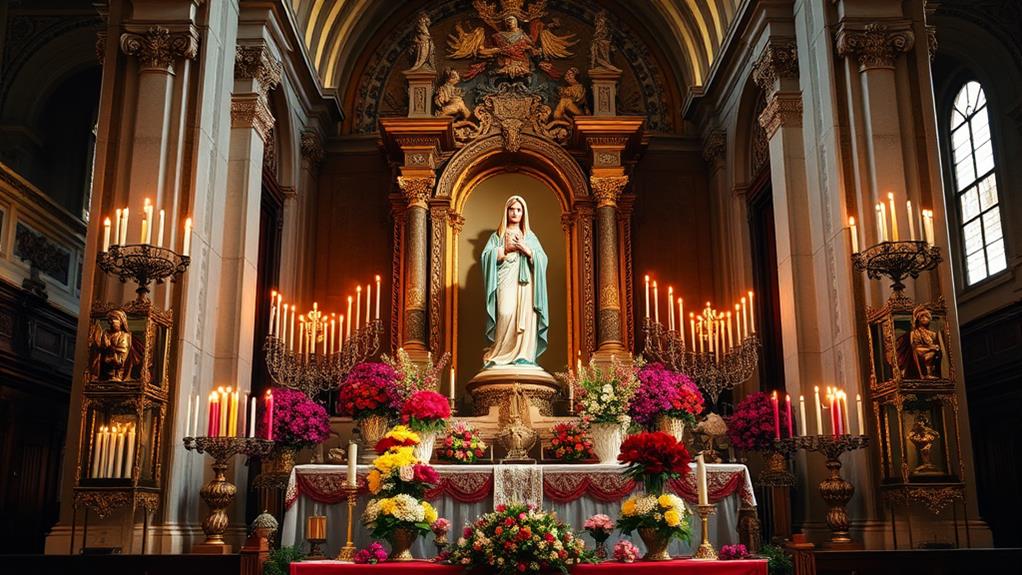
The Devotion to Santo Niño Evolved Significantly Over the Centuries.
The discovery of the image of Santo Niño by Juan de Camus in 1565 marked a pivotal moment in the historical background of Christianization in the Philippines. This event catalyzed the formal introduction of Christianity, establishing Santo Niño as a focal point of devotion.
The Devotion Gained Momentum Over Time.
As the years passed, the devotion to Santo Niño grew, culminating in the establishment of the Feast of Santo Niño on the third Sunday of January. This strategic move prevented conflicts with Easter celebrations.
Pope Innocent XIII's approval of the liturgy further solidified its importance.
A Significant Milestone Was Reached in 1965.
During the centenary celebration of Christianization, the Minor Basilica del Santo Niño was canonically crowned by Pope St. Paul VI, symbolizing its status as the oldest Christian relic in the Philippines.
The Devotion Continues to Thrive Today.
The devotion incorporates daily Novena Masses leading up to the feast day, reflecting its deep-rooted cultural heritage and the ongoing reverence for Santo Niño across the nation.
The Santo Niño Image and Symbolism
The Santo Niño Image: A Symbol of Filipino Spirituality
The Santo Niño image is a powerful symbol in the Filipino spiritual landscape, closely tied to the evolution of devotion to the Child Jesus. This image depicts the Child Jesus as a king, emphasizing his divine authority through his globe and scepter. This representation resonates deeply with the cultural identity of Filipino Catholicism, as the Child Jesus is often adorned in red and gold vestments, embellished with precious gems donated by devotees.
The Image's Transformations Reflect Cultural Shifts
Throughout history, the Santo Niño has undergone transformations, including a period when it was painted black. This adaptability reinforces its significance as a religious icon that bridges Catholic faith with indigenous beliefs. The image's role extends beyond mere representation, as it acts as a focal point in numerous religious and cultural celebrations, embodying the rich symbolism inherent in Filipino spirituality.
Devotion to the Santo Niño: A Blend of Faith and Identity
The devotion to the Santo Niño encapsulates a unique blend of faith and identity. This devotion is a profound element of the Filipino religious experience, as it brings together the Catholic faith and indigenous beliefs.
The Santo Niño image serves as a powerful symbol of this blend, reflecting the cultural identity of Filipino Catholicism.
Role of Augustinian Friars
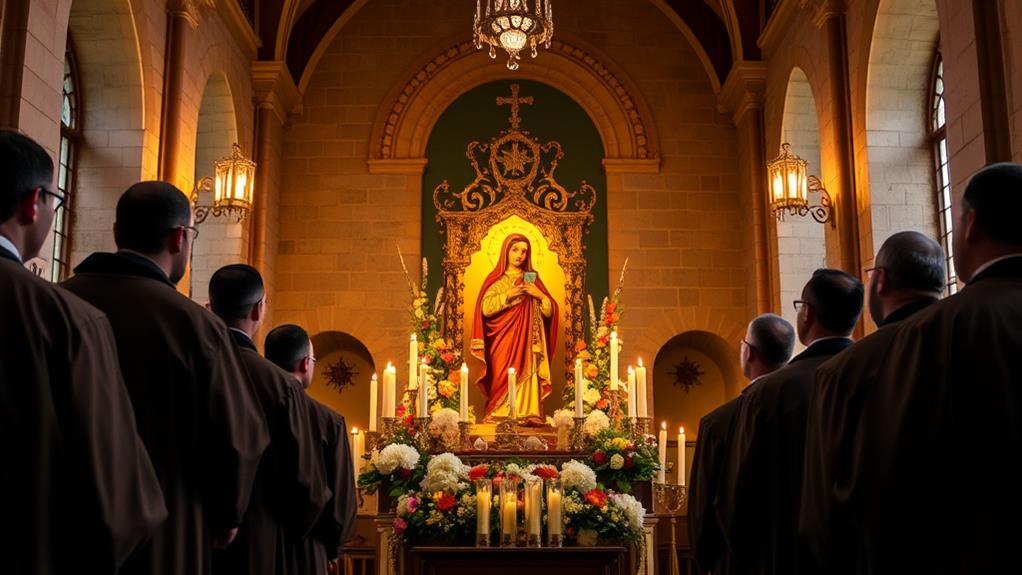
The Augustinian friars played a crucial role in spreading the devotion to Santo Niño in the Philippines. They established a convent dedicated to promoting this devotion after the Santo Niño was brought to the Philippines in 1565. This convent became a hub for promoting the devotion, and the friars' efforts extended beyond Cebu as they built churches in various regions, significantly influencing the religious landscape across the archipelago.
The Augustinians fostered community involvement by establishing the Cofradia del Santo Niño de Cebu, the oldest cofradia in Asia. This organization illustrates their commitment to nurturing a collective religious identity among devotees.
Miguel López de Legazpi, the first hermano mayor, played a key role in promoting this community involvement. The Augustinians also organized elaborate processions marking the novena and the grand feast celebration, which drew around one million participants. These events demonstrate the strong connection between the religious community and the devotees.
The Augustinian friars not only promoted the Santo Niño devotion but also integrated it into the broader Filipino identity. Through their activities, they made a lasting impact on the spiritual and cultural fabric of the nation.
Community Involvement and Devotion
Community Involvement and Devotion
The devotion to Santo Niño is deeply rooted in the community, thriving through active participation and shared rituals among devotees. The Cofradia del Sto. Niño de Cebu, the oldest cofradia in Asia, plays a pivotal role in fostering community involvement. Its first hermano mayor, Legazpi, emphasized collective devotion, which is evident in the grand procession on the eve of the feast, where around one million participants engage in the communal celebration.
Daily practices at the Minor Basilica del Santo Niño demonstrate this engagement. Devotees partake in rituals such as touching the glass case, lighting candles, and performing traditional dances as acts of prayer.
The opening of the novena features a 2-kilometer procession, showcasing local commitment to the Santo Niño celebration. Additionally, personal expressions of faith manifest through individuals carrying their own images of Santo Niño and participating in traditional dances during festivals.
This vibrant involvement not only strengthens community ties but also reinforces a shared identity rooted in faith, making the devotion to Santo Niño a significant cultural cornerstone.
Popular Religiosity and Practices
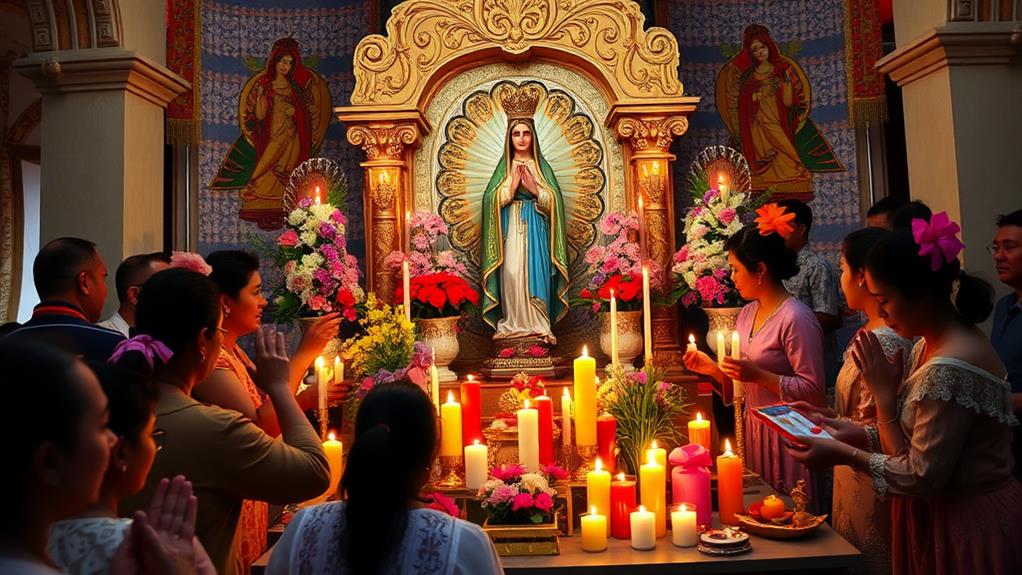
Devotees Express Popular Religiosity
Devotees express their popular religiosity through various practices centered around the Santo Niño, showcasing a profound cultural connection.
Daily Holy Mass at the Minor Basilica del Santo Niño attracts large numbers, demonstrating vibrant communal expressions of faith. During these masses, devotees perform rituals such as touching the image for strength and healing or lighting candles, illustrating their deep-rooted devotion to the holy. These practices embody not only individual piety but also collective cultural identity.
The Sinulog Festival: A Celebration of Devotion
The Sinulog festival, celebrated annually on the third Sunday of January, exemplifies this devotion through street dancing and fluvial parades.
Millions participate, demonstrating the cultural diversity within Filipino religious practices and affirming their connection to the Santo Niño. The chant "Pit Señor" resonates during traditional dances and processions, signifying a call to the Lord that fuses folk religiosity with official liturgy.
Widespread Integration of Santo Niño Veneration
The existence of over a hundred shrines and chapels dedicated to the Santo Niño across the Philippines highlights the widespread integration of this veneration into various communities.
These elements collectively illustrate how the Santo Niño serves as a focal point for cultural expression and spiritual devotion among Filipinos.
Festivals and Cultural Celebrations
Festivals honoring the Santo Niño in the Philippines are a vital expression of faith and cultural identity. These celebrations intricately weave religious devotion with cultural traditions.
The Sinulog Festival is a prime example, held on the third Sunday of January in Cebu. It attracts millions of participants in vibrant street dancing, parades, and religious processions.
Other notable festivals celebrating the Santo Niño include:
Ati-Atihan Festival, which honors the Santo Niño through rhythmic dances and painted faces, rooted in indigenous Filipino traditions.
Dinagyang Festival, an adaptation of the Ati-Atihan, features participants in elaborate costumes, celebrating Santo Niño while showcasing Iloilo's rich cultural heritage.
Fluvial Parades involve devotees carrying the Santo Niño image on boats, symbolizing both the journey of faith and community solidarity.
These annual celebrations reflect a deep-rooted devotion to the Santo Niño and incorporate various novenas and community events.
The traditional Sinulog dance, characterized by a two-step forward and one-step backward pattern, embodies the flowing current of Cebu's Pahina River, solidifying the ties between religious practice and cultural expression.
Cultural Syncretism and Identity
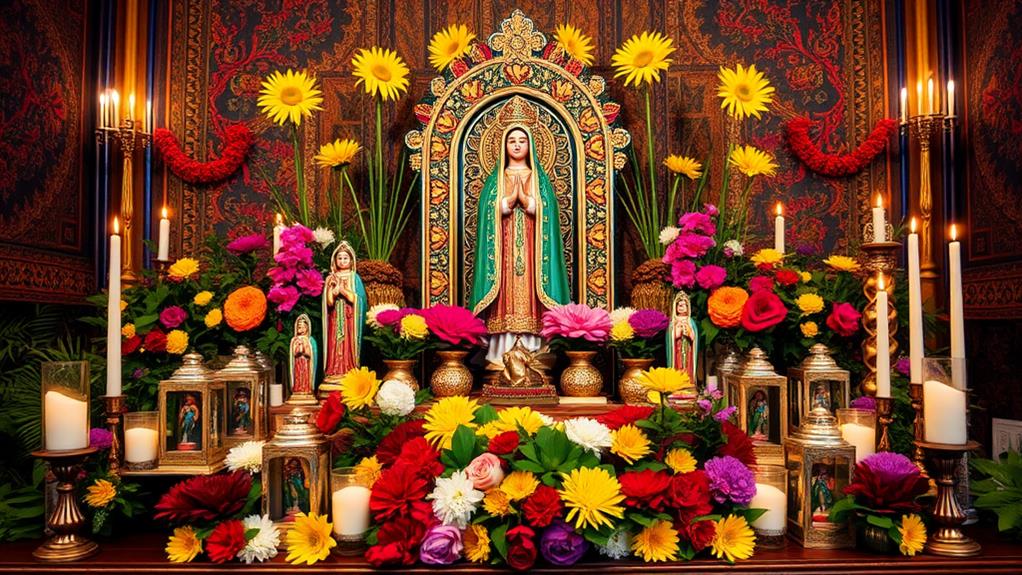
Cultural Syncretism and Identity
The Santo Niño: A Symbol of Unity
The devotion to the Santo Niño in the Philippines is a prime example of cultural syncretism, where indigenous beliefs merge with Spanish Catholicism.
This unique fusion creates a harmonious coexistence of Catholicism and traditional practices.
Festivals and Rituals
Festivals like the Sinulog showcase the Santo Niño devotion and indigenous heritage through traditional dances and colorful costumes, strengthening communal bonds.
Daily rituals, such as lighting candles and performing dances in honor of the Santo Niño, reveal the deep interplay between faith and everyday life.
These practices not only highlight individual devotion but also strengthen cultural identity within communities.
Preserving Spiritual Identity
The widespread presence of Santo Niño religious objects in homes and churches across the archipelago signifies a profound commitment to this figure, embodying resilience and adaptability in the face of historical change.
The integration of animistic elements with Catholic rituals underscores how Filipino culture has assimilated foreign influences while preserving its distinctive spiritual identity.
Defining Filipino Identity
Through this cultural syncretism, the Santo Niño becomes a symbol of unity, reflecting a rich tapestry of beliefs that define what it means to be Filipino today.
What are the similarities and differences between the devotion to the Santo Niño and the Black Nazarene?
The devotion to the Santo Niño and the Black Nazarene both involve strong beliefs and rituals. However, the Santo Niño is associated with joyful celebrations and colorful processions, while the Black Nazarene tradition is marked by intense physical displays of faith, such as the annual barefoot procession in Quiapo, Manila. Understanding the black nazarene tradition helps to appreciate the differences in devotional practices.
Acculturation and Adaptability
Acculturation and Adaptability in Filipino Devotion
Acculturation has played a crucial role in shaping the devotion to the Santo Niño, illustrating how indigenous beliefs have adapted to Spanish Catholicism. This process highlights the dynamic interplay between cultural identities, resulting in a rich tapestry of religious practices that reflect Filipino resilience and adaptability.
Festivals as Cultural Expression
The Santo Niño is at the center of vibrant festivals like the Sinulog Festival, which integrates traditional dance and music.
These celebrations showcase the Santo Niño's importance in Filipino cultural expression, highlighting the successful blending of indigenous and Catholic traditions.
Merging Local Aesthetics with Religious Iconography
The Santo Niño is often depicted in native garments,
merging local aesthetics with religious iconography. This fusion reinforces cultural pride and identity, demonstrating the ability of Filipino culture to adapt and evolve.
Community Practices and Collective Faith
Rituals like processions and novenas highlight the collective faith of communities,
illustrating how these practices have evolved while keeping core Christian tenets intact. These community practices demonstrate the strong sense of community and shared faith that characterize Filipino devotion.
The Santo Niño serves as a focal point for examining the intersection of these elements,
revealing how Filipino devotion navigates historical changes. This unique blend of Catholicism and Filipino culture has resulted in a vibrant religious image that honors both traditions.
Insights From Post-Vatican II Perspectives
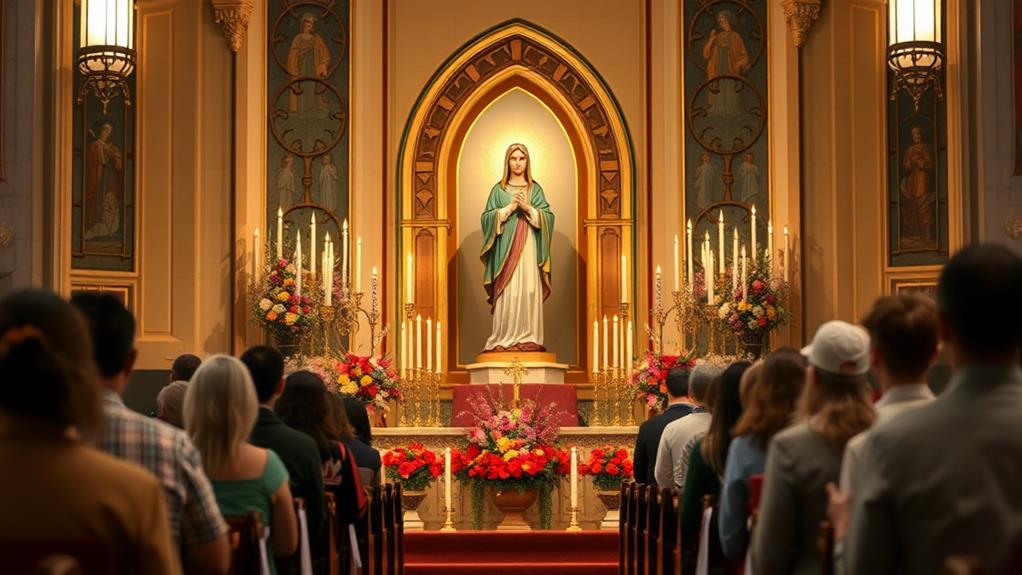
Filipino Culture and Catholicism Intertwine
The devotion to the Santo Niño in the Philippines is a prime example of cultural syncretism, where indigenous practices and Catholic teachings merge to form a unique religious identity. This blending of cultures is a dynamic interplay, illustrating that faith in the Philippines isn't simply a Western import, but a rich tapestry of historical and contemporary expressions.
The Santo Niño Symbolizes Cultural Resilience
The Santo Niño embodies the adaptability of Filipino spirituality, and festivals like Sinulog serve as vibrant platforms for community expression, reinforcing the connection between faith and identity.
The Santo Niño devotion demonstrates cultural resilience, showcasing the ability of Filipino spirituality to adapt and thrive.
Post-Vatican II Insights Promote Cultural Sensitivity
Post-Vatican II perspectives urge the global church to acknowledge and embrace diverse Catholic expressions, as seen in the Santo Niño devotion.
This understanding fosters a deeper appreciation for how local traditions enrich the universal Church. By recognizing the significance of the Santo Niño, we engage with the broader implications of faith that resonate with Filipino communities, promoting a more inclusive and respectful approach to Catholicism in a multicultural world.
Questions and Answers
What Is the Significance of the Santo Niño?
The Santo Niño holds profound cultural and historical significance. This is evident in its role as a symbol of childlike faith, inspiring community gatherings and artistic representations.
For example, in the Philippines, the image of the Santo Niño is often depicted in colorful and vibrant processions, showcasing the country's rich cultural heritage.
The Santo Niño is a focal point for pilgrimage and devotion, leading to global celebrations.
In Cebu, Philippines, the Sinulog Festival is a prime example, where millions of devotees gather to honor the Santo Niño and seek its blessings.
The Santo Niño serves as a conduit for intercessory prayers, reinforcing its role in spiritual symbolism.
Devotees believe that the Santo Niño connects them with their heritage and shared beliefs, providing a sense of unity and community.
What Is the Santo Niño Devotion?
The Santo Niño devotion is a rich cultural and religious tradition with historical significance.
Artistic representations of the Santo Niño can be found in various pilgrimage sites across the Philippines, which serve as community gathering places that foster spiritual symbolism.
This devotion extends beyond the Philippines, influencing both Filipino and non-Filipino communities globally.
The Santo Niño devotion intertwines faith and culture, reflecting a vibrant heritage that continues to thrive today.
What Is the Moral Lesson of Santo Niño of Cebu?
The moral lesson of Santo Niño of Cebu emphasizes humility and simplicity as vital for spiritual growth.
In this devotion, people come together to participate in rituals, promoting community unity and faith expression. This collective participation reflects the rich cultural heritage of the region, highlighting the importance of charity work and personal reflection.
The historical context of Santo Niño also showcases a global influence, inspiring believers to embrace a childlike faith in their spiritual journeys.
What Is the Message of the Feast of Sto. Niño for All of Us Christians?
The Feast of Sto. Niño teaches valuable lessons for Christians.
This celebration emphasizes the importance of childlike faith and humility in prayer. It shows that prayer should be sincere and humble, like a child's. For example, when we pray, we should be willing to listen and learn, just as a child listens to their parents.
Joy in worship is also a key aspect of the Feast of Sto. Niño. This festival encourages Christians to celebrate their community and cultural heritage with enthusiasm and happiness. During the celebration, people come together to honor the Child Jesus, which fosters a sense of community and belonging.
The Feast of Sto. Niño reminds us of the innocence of the Child Jesus. This innocence represents the values of parental guidance and love for God. As Christians, we're called to emulate these values by seeking guidance from our spiritual leaders and loving God with all our hearts.
Through this celebration, spiritual growth flourishes. By reflecting on the values embodied by the Feast of Sto. Niño, Christians can deepen their faith and connections with their community.
This, in turn, fosters a stronger sense of spirituality and belonging.